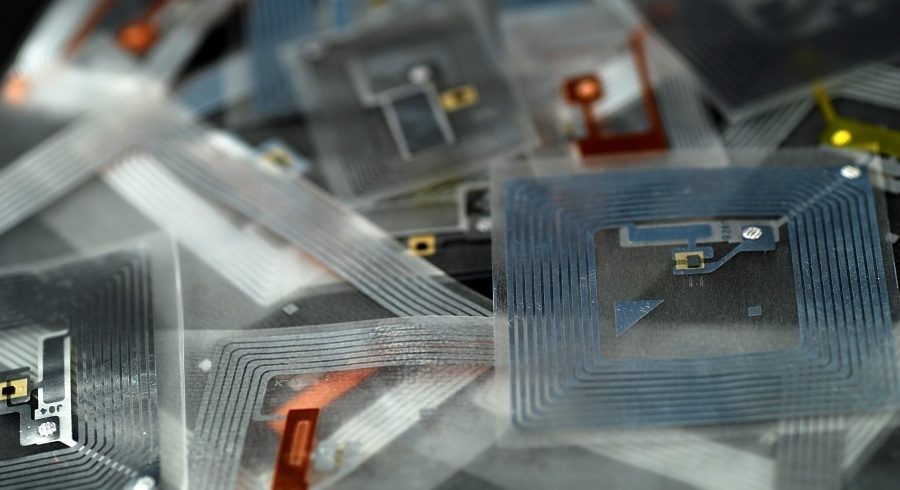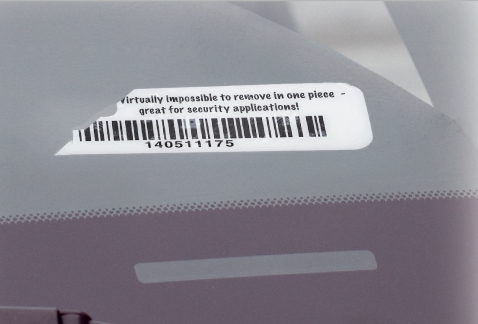Radio-frequency identification (RFID) takes customization to a whole new level and Metalcraft is with you every step of the way. Customization for RFID requires extensive qualification because not only do you need to qualify the technology to ensure a successful application, but you must also qualify the environment to ensure the proper RFID tag construction.
 RFID Inlay – the Foundation of the Tag
RFID Inlay – the Foundation of the Tag
RFID inlays are not one-size-fits-all.
First, the inlay selected must fit into the allotted space.
Second and, more importantly, the inlay must provide the required read range for a successful application. Typically, the larger the inlay the longer the read range.
Third, the inlay must also be matched to the surface to which it is applied. Not all inlays work well on all surfaces. Some inlays are specially designed and tuned to work on specific surfaces. Metal and glass are examples of surfaces where specialty inlays may be used.
Metalcraft is inlay agnostic meaning we can source and work with virtually any inlay currently available – and even ones that are not yet available. Metalcraft’s engineers can design a custom inlay for specific applications requiring that level of customization.
T aking customization even further – users may also request a specific chipset. They may prefer a chip deemed more sensitive than others. Depending on the application, users may also need a chipset with extended memory banks available or they may want a chipset with an error-correcting feature.
aking customization even further – users may also request a specific chipset. They may prefer a chip deemed more sensitive than others. Depending on the application, users may also need a chipset with extended memory banks available or they may want a chipset with an error-correcting feature.
Security features such as strategically placed slits are another form of customization used independently or combined with destructible material, RFID tags with security slits not only provide the primary tracking function but also help deter theft and unauthorized removal by designing the slits right into the RFID inlay.
RFID Tag Customization – Going Beyond the Inlay
As previously mentioned, qualifying and customizing the technology/inlay is just one aspect of customization of an RFID tag. The construction of the RFID tag itself can be customized depending on the objective of the application and the results of the qualification exercise.
 Looking at the construction of the RFID tag, literally, everything you want to customize for a non-RFID polymer label holds true for RFID. from the material being printed on, to the way it is being printed, to how it is affixed to the surface of the item it is tracking – everything can be customized to fit your needs.
Looking at the construction of the RFID tag, literally, everything you want to customize for a non-RFID polymer label holds true for RFID. from the material being printed on, to the way it is being printed, to how it is affixed to the surface of the item it is tracking – everything can be customized to fit your needs.
Let’s take a closer look at each of these. Environmental exposure, expected lifetime, and cost are some of the considerations that go into selecting both the type and thickness of the material needed from an RFID tag. Polyester will last longer than polypropylene, for example, but polyester will also be more expensive.
Custom colors are a little thing that can make a big difference. In addition, subsurface printing protects the digitally printed, flexo printed, or even thermal transfer printed imagery, copy, and barcode either by printing on the reverse side of the substrate, i.e. polyester, or by placing a laminate over the surface printed imagery, copy, and barcode.
Just like the substrate, environmental conditions play a huge role in selecting or customizing an adhesive or affixing method. Even more important is the surface to which the RFID tag is applied. For example, a high surface energy object like unfinished metal needs to be matched with a high surface energy adhesive to ensure maximum adhesion. Or extremely high temperatures (greater than 750°F) requires either a special adhesive or holes with mechanical fasteners.
We’ve already addressed destructible or tamper-resistant features that can be incorporated into the RFID inlay and the same holds true for the material itself. Paint resistance is another customization that can be built into an RFID tag - either a one-time or a more “permanent” paint-resist solution.
Metalcraft Customization Services – Taking Concepts to Reality
 Customization can be as simple as printing a company logo on a standard product or it can be as extensive and complex as designing a completely new product from scratch for a specific application. Metalcraft has the design, engineering, and manufacturing capabilities to bring ideas to life – from a one-piece prototype to a full-scale production run of millions.
Customization can be as simple as printing a company logo on a standard product or it can be as extensive and complex as designing a completely new product from scratch for a specific application. Metalcraft has the design, engineering, and manufacturing capabilities to bring ideas to life – from a one-piece prototype to a full-scale production run of millions.
